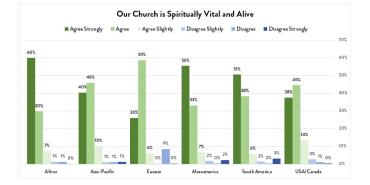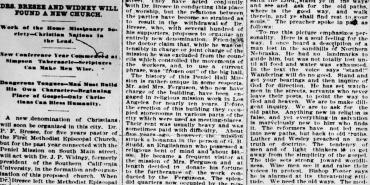Stained-Glass Sexuality: Restoring Wholeness in a Disintegrated World

One of the most striking aspects of the creation narrative is the concept of tobh or tov, God’s proclamation that His creation is defined by His inherent goodness. It is an expression of congruence between the Maker and that which He has made, the resonance of love between a Father and that which has been birthed into existence. Inherent in this goodness, we see connectedness and relationality as defining features of the created world, epitomized by the first man’s awakening attunement to God, to creation, and ultimately, to another—woman.
The Beautiful Gift of Sexuality
In fact, the first space where this goodness is compromised is in the state of disconnection, as Scripture states, “It is not good for man to be alone” (Gen. 2:18).
This goodness is reflected in the spiritual, emotional, and physical intimacy shared within the covenant of marriage. It is a covenant that is intended to emulate the same self-giving nature and agape that is rooted in the Trinity (Eph. 5:21-33), and captured in the phrase, “Two will become one flesh” (Gen. 2:24; Mark 10:8; Matt. 19:5-6; Eph. 5:31).
Two becoming one flesh is far more than a sexual euphemism; rather, it allows us to see the unfolding of God’s design for the beautiful gift of sexuality. It is a gift that is found in our human physiology, in the procreative and unitive dimensions that serve to proclaim the gospel even on a biological level. We were created specifically for connection by a God who, by His very nature, is connection. We bear the image of our Creator. Through this lens, every aspect of intimacy within the covenant of marriage and every dimension of human sexuality we have been gifted is intended to be the goodness of God revealed in us.
Disintegrated Living and the Distortion of the Gift
While there is intrinsic goodness within the gift of sexuality that we have been created with, we need not look far in our fallen world to find a number of ways in which the gift has been distorted. Pornography, sexual trauma, early sexualization, infidelity, and sexual addiction serve as primary indicators that a great fragmentation has occurred, leaving us in a state of disintegrative living. Though it would be easy for us to assume that these distortions exist exclusively outside of the safe confines of our seat in a Sunday morning pew, a brief self-reflection among the faithful would suggest that these behaviors are as common among God’s people as they are among the world we are called to evangelize.
At times our best efforts to live in the world have softened us to the temptations of the world.
Evidence of the fragmenting effect of sexual sin is seen in the church among clergy and laity alike.
One primary example of disintegrated living is the disconnection between the mind and the body while watching pornography. The mind is consuming images that have nothing to do with the physical reality of the individual, while the body responds as if it is the individual participating in the act that the mind is perceiving. This leads to a distorted manifestation of sexuality and divorce from reality. Individuals continue to do things that fragment the connection of their body, mind, and soul, and separate them from what God intended. The distortion of the good gift of sexuality often results in the fracturing of relationships and the destruction of family systems. As a church, we have been here before (Rom. 1; 1 Cor. 6).
In many ways, our well-intended (albeit somewhat misguided) attempts as a church to navigate the many cultural distortions of sexuality have contributed more to the perpetuation of the problem than to the restoration of sexuality to its place of goodness within God’s design. The veil of secrecy and silence in the church about the various facets of human sexuality have left an indelible sense of shame in our Christian imaginations. Our shame-based sexual ethic has come to emulate the same covering and hiding that occurred the moment sin entered the world (Gen. 3).
Yet, in the darkness that grows in a culture of sexual distortion, we have a hope to cling to: “Thanks be to God, who delivers me through Jesus Christ our Lord!” (Rom. 7:25).
The Reintegrative Power of the Gospel
One primary theme throughout the Gospels and in Paul’s epistles is the idea of reintegration. This is the process by which the things that have been torn asunder through the consequences of sin are restored to wholeness by the transforming power of grace. We see this call to reintegration in Christ’s answer to the question about the greatest commandment: “Love the Lord with all your heart and with all your soul and with all your mind and with all your strength. The second is this: Love your neighbor as yourself” (Mark 12:30-31; Matt. 22:37-40).
We are created for a wholeness that gives us the ability to love others like Jesus, which begins with consecration of all of our body, mind, and soul to Him.
This model of reintegration extends into the pair-bonding and procreative dimensions of God’s design for sexuality.
In Scripture, Jesus emphasized His interest in reintegrating us to wholeness. He engaged those who lived in a distorted narrative of sexual sin. Regarding the pair-bonding nature of human sexuality, we see Christ encounter the Samaritan woman at the well in John 4. Her story is a common one for many men and women in the modern world: a history of failed relationships, an apathy about commitment, an unwillingness to entrust herself to anyone completely, and a broken sense of self-worth. It is in this place of personal shame and social disconnection that Jesus offers her a chance to drink from the living water and to have her deepest desires all fulfilled in Him.
He restores her from a place of disordered relationality and impaired capacity to bond with others to the full measure of being known, affirmed, included, and chosen. This is the gospel we are invited to enter into, experience, and proclaim.
Alongside this unitive dynamic of the sexual system, we see Jesus also restoring the procreative dynamic. The bleeding woman who touches the hem of His cloak was subjected to a condition for 12 years that rendered her unclean and forced her to the fringes of Jewish society (Mark 5). The nature of her bleeding may indicate a concern emerging from her reproductive system, but the restoration she experienced was far more than just biological; it was also a significant social and spiritual restoration, which serves as an important example for the church today.
We must examine the notion of procreation through a more intentionally Christian lens. Maternity and paternity cannot be used as the benchmark for biological procreativity, for there are many whose roles and responsibilities will never involve bringing physical life into existence. Rather, the idea of procreative reintegration within the church should instead focus on the exertion of energy by all parties toward nurturing those who are young, those who are vulnerable, those who are weak, the orphan and the widow, and any who are in need of the unconditional love emanating from the heart of the Father. In this paradigm, the reproductive health of the church, namely evangelization and discipleship, invites all persons to co-labor in the effort to raise mature followers of Jesus, regardless of age or ability. Thus, the making of Christlike disciples in the nations becomes dependent on the Body of Christ reintegrating its procreative potential, primarily the fervent proclamation of the gospel and the sharing of God’s love for those who bear the scars of existing in a sexually distorted world.
Perhaps the best model for us to draw on in thinking about the reintegration of goodness into God’s design for sexuality is a stained-glass window. For centuries, small pieces of glass, by themselves insignificant, have been brought together and crafted into beautiful mosaics that often depict the story of God’s love for His creation.
Light shines through, and out of the collection of fragments, a story of redemption emerges.
These bits of glass tend to resemble the fragmented moments from our own sexual pasts: the mistakes we have made, the struggles we have secretly carried, the shame that has suffocated us, and the failures we have buried deep inside. When surrendered to Christ, His light can shine through, transforming and redeeming us. Through His power, we can use our past as a witness to those in our midst who need God’s holy love. In a broken world where sin has left many of us sifting through the shards of past sexual mistakes, shame, struggles, and failures, may we come to know intimately and declare boldly the wholeness and redemption that we find only in our Creator.
Todd Bowman is associate professor of counseling at Indiana Wesleyan University.
Holiness Today, Nov/Dec 2019
Please note: This article was originally published in 2019. All facts, figures, and titles were accurate to the best of our knowledge at that time but may have since changed.




